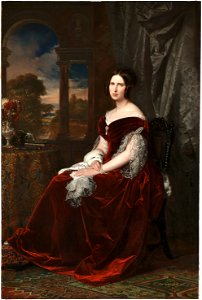It is one of the best full-length female portraits from the most intensely romantic period of its author, comparable only to that of leocadia zamora (private collection), two years later. The posture of the lady, sitting on a chair in front of a viewpoint, with her hands joined in her lap and a handkerchief under one of them and with one foot resting on an embroidered cushion, has a precedent in the portrait, ten years earlier, of maría manuela kirkpatrick, countess of montijo (casa de alba foundation, palacio de las dueñas, seville). However, in the ten years that had passed, the artist had made notable progress in his painting. The qualities of the maroon velvet dress, its waters and folds, which enhance the white clarity of the neckline and arms, the softness of the delicately turned modeling of these, the elegance of the arrangement of the hands, the beauty of the transparency of the lace, made with a brushstroke of accurate writing, as well as the execution of the bracelet and the pearl decoration and the brooch with pinjante on the neckline, reveal a subtly stylized interpretation of the portrait of gran style, appropriate to show the condition of maximum prominence among the wealthy bourgeoisie of madrid, of the portrayed. It is further ennobled by the curtains and architecture of the serlian belvedere that express the hierarchy and high culture of the lady, while the background of the picturesque park with a lagoon surrounded by trees is related to the naturalness of her character. In this interpretation, especially in the sunset landscape, the british suggestion is notable, which attests to federico de madrazo's knowledge of that school, as well as his intelligence to use it on this occasion with complete propriety, given the origin of the lady and her husband (text extracted from barón, j. In: memoria de activities 2014, museo nacional del prado, 2015, pp. 50-53). Object Type: painting. Date: 1846. Dimensions: height: 200.6 cm (78.9 in); width: 133.4 cm (52.5 in). Medium: oil on canvas. Collection: Museo del Prado. Sabina Seupham Spalding, por Federico de Madrazo
Loading...
